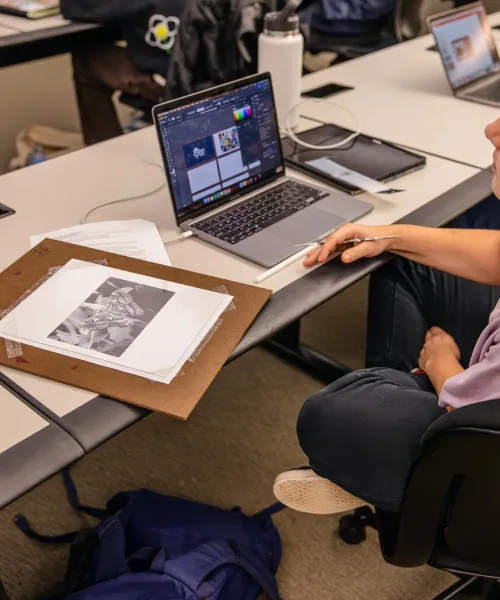Quick Links

About the Program
The Graphic Design program at NMU prepares students to create effective visual communication across print, digital, and interactive media. Students develop skills in typography, illustration, photography, and motion graphics while learning to manage projects, collaborate with teams, and work within real-world constraints such as time, budget, and technology.
Supporting courses in Illustration, Photography, Digital Cinema, and Electronic Art & Animation help students expand their creative toolkit.
Graduates pursue careers in design firms, advertising agencies, corporations, and non-profits, with alumni employed in cities including Detroit, Chicago, Madison, Minneapolis, and San Francisco.
Graphic Design Faculty
Keith Ellis
Professor
keiellis@nmu.edu
906-227-1861
Thomas Adolphs
Assistant Professor
tadolphs@nmu.edu
906-227-1483
Graphic Design Courses
ARTD 218 Graphic Design: Foundations
4 credit hours
Offered: Fall, Winter
Introduction to graphic design concepts with the development of technological and craft skills. Emphasis is placed on the use of process, typography, and composition, as well as foundational skills in gestalt and color theory.
AD 318A Graphic Design: Typography and Layout
4 credit hours
Offered: Fall, Winter
Prerequisite: AD 218
Implementation of typographic systems in concept and composition. Emphasis is placed on process, letterform, and layout, as well as typography’s use in interactivity and social media.
AD 318B Graphic Design: Storytelling and Production
4 credit hours
Offered: Winter
Prerequisite: AD 218
Advanced studies in visual systems through conceptual development, production skills, and three-dimensional design. Emphasis is placed on a narrative approach to design.
AD 388 Web Design
4 credit hours
Offered: Fall
Prerequisite: AD 218
Advanced studies in the design and development of websites. Emphasis is placed on the conceptual development and layout of websites as well as their use in multiple devices and environments. Front-end HTML and CSS coding will be developed throughout the course.
AD 418 Graphic Design: Interactive Design and User Experiences
4 credit hours
Offered: Fall
Prerequisite: AD 303 or concurrent enrollment, AD 318A or AD 318B; or instructor permission.
Students will learn to apply research, problem-solving, and the user’s experience to interactivity. This course’s focus is on app/software interfaces and other media, wayfinding, and the conceptual development of interaction and design.

Computer Studio
Graphic Design students use the shared Art & Design Computer Studio, which includes four labs, two for laptops and two equipped with Apple computers, large flat-screen displays, Wacom drawing tablets, and scanners. Students have access to industry-standard software such as Adobe Photoshop CC, Adobe Illustrator CC, Adobe InDesign CC, Adobe Dreamweaver CC, and Adobe After Effects CC.
Graphic Design FAQ
What is Graphic Design?
Graphic Design is the study and practice of visual communication. Designers create layouts using typography, illustration, photography, and digital media to convey ideas, information, and messages. While traditional graphic design focused on print-based media, the field now includes web, social media, motion graphics, and other digital platforms.
Is Graphic Design the same as Advertising?
Advertising is visual communication specifically intended to sell a product or service. Graphic Design is broader, focusing on informing, inspiring, and conveying concepts. Our program emphasizes Graphic Design, but students may explore advertising projects as part of coursework. Advertising courses are offered through the College of Business, and students pursuing a Bachelor of Science may combine a Graphic Design major with a minor in Marketing or Business Management.
What is the difference between Graphic Design and Electronic Art & Animation?
Graphic Design emphasizes print, layout, and visual systems, while Electronic Art & Animation focuses on 3D modeling, animation, and motion graphics. Both programs share some web and interactive design coursework, and Graphic Design students may take selected Electronic Art & Animation courses if pursuing a BFA degree.
What is the difference between a BFA and a BA or BS degree?
The Bachelor of Fine Arts (BFA) is the professional studio degree, including the most Art & Design coursework with a strong studio emphasis.
The Bachelor of Arts (BA) and Bachelor of Science (BS) allow more flexibility, including a 20-credit minor outside the School of Art & Design. The BA requires a language minor, while the BS allows other minors. These options let students combine Graphic Design with complementary fields to broaden their expertise.
Will I need to submit a portfolio for admission?
If you are accepted to the university, you may pursue a degree within the School of Art & Design. A portfolio review is not required for admission; however, all Art and Design majors must complete a faculty review of their work through AD303: Individual Art Review. The review is held in the twelfth week of each semester.
For information on general University admission requirements, contact the Admissions Office.
Are there scholarships available for incoming first-year students?
For information about scholarships for incoming freshmen, please visit the Scholarships & Financial Aid page.
